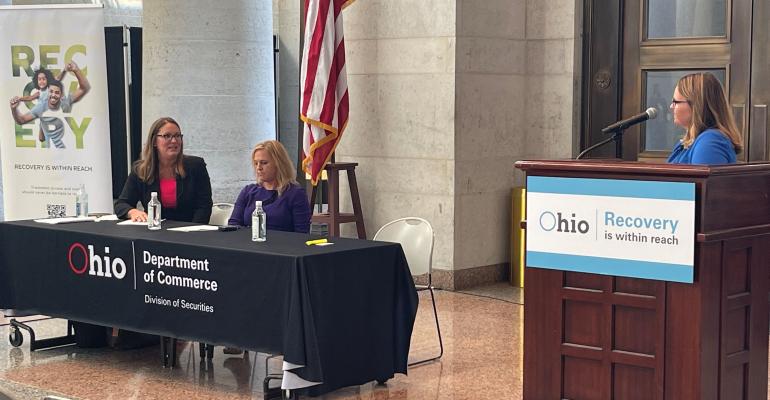The Ohio Department of Commerce has introduced a new program to help financial advisors in the state to spot the signs of a family facing the emotional and financial costs of opioid addiction, and how to help them through those struggles.
According to the department, it’s one of the nation’s first statewide initiatives focusing on advisors’ role in curtailing the opioid epidemic.
The new “Recovery Within Reach” initiative will include public service announcements on television, radio and digital throughout the state that will direct advisors and others towards a new website with further information, including a map for advisors, clients and anyone else to find the nearest (and most affordable) treatment options.
The department’s Securities Division is also developing training modules for financial advisors that will be rolled out this year, according to Ohio Securities Commissioner Andrea Seidt, who made the announcement Tuesday morning, with Gov. Mike DeWine participating remotely.
Seidt shared results from a newly-released statewide survey of advisors, detailing their perspectives on clients’ struggles with opioid addiction. The median financial impact someone’s addiction could have on a family was estimated to be about $35,000 annually. And advisors believed only 1% of clients had their finances affected by opioid addiction, despite the fact that one in 13 Ohioans live with a substance abuse disorder.
“I hear about it everyday; you can’t pick up a paper or read a headline without knowing how serious this epidemic is raging in our state,” Seidt said. “We’re the epicenter of the crisis in our country, so I was shocked that they were estimating it at such a low percentage.”
Seidt was joined by Lori Eisel, president of the Pickerington, Ohio-based RIA Arcadia Financial Partners, who detailed her own family’s experience with opioid use. When Eisel learned her son was suffering from addiction, she said she did not know where to start, and there was a “massive amount of out-of-pocket expense” in helping her son get the assistance he needed. While Eisel said she was lucky to have insurance, she knew others may not be as fortunate.
“It’s also tough to quantify the other things that go along with that: lost wages, health care expenses, automobile accidents, costs the insurance won’t necessarily cover,” she said. “It can be financially and emotionally devastating for families.”
According to the Securities Division, Ohio remains in a crisis, with 13 individuals in the state dying each day from unintended drug overdoses (while opioids account for 84% of drug overdoses in the state). Ohio currently has the country’s fourth-highest drug overdose rate, according to the division.
Nationwide, drug overdoses have continued to climb over the past two decades, according to data from the Centers for Disease Control; in 2020, about 91,800 drug overdose deaths occurred in the U.S., a 31% age-adjusted increase from the prior year. Opioids were the main driver of these fatalities, according to the CDC.
Eisel said financial advisors could act as the first chance to spot worrying red flags, and they should be on the lookout for clients taking large or small amounts of cash from their portfolios, repeatedly buying vehicles or depleting retirement funds. Too often, victims of addiction (or their families) came to advisors after the monetary damage had already been done.
“We would like to see them more proactively reach out to financial planners to help them plan for the cost of treatment, to understand the resources available so they’re not raiding their retirement plans and putting themselves at financial risk,” Eisel said.

